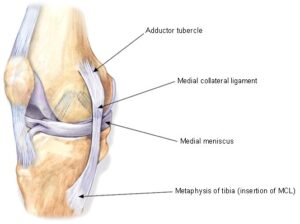Knee Medial Collateral Ligament Sprain - Fact Sheet
What is it?
The medial collateral ligament of the knee (or MCL), sits on the medial side of the knee joint. It works to resist valgus forces (buckling inwards) on the knee. It is “tight” at full extension of the knee, and at its most “lax” at 30degrees of knee flexion/bend.

What causes an MCL strain?
Generally, a twisting or hyperextension injury of the knee can cause some damage to the MCL. Another mechanism of injury is a direct blow to the outside of the knee that forces the knee to buckle inwards. It is not uncommon for other injuries to occur in conjunction with an MCL injury, namely involving the ACL and/or medial meniscus

Signs and Symptoms
• Medial knee pain and swelling
• Inability to fully straighten the knee
• Feeling of knee buckling/instability when walking or changing direction
• MCL injuries are graded from Grade I to III.
– Grade I – stretching of the ligament fibres, but most fibres intact. Mild pain +/- swelling.
– Grade II – damage to a percentage of the ligament fibres, moderate to severe pain and swelling.
– Grade III – most or all of the ligament fibres are torn or compromised. Significant swelling present, +/- pain.

Treatment of Knee Medial Collateral Ligament Sprain?
Limiting Range of Motion – depending on the grade of injury, limiting the range of motion of the knee helps to heal and restore the fibres of the MCL. This is generally done in a limited motion knee brace for grades II to III, or with rigid taping techniques for grade I. this helps reduce the stretching forces on the ligament, so the disrupted ends of the ligament can heal back together.
Tailored Clinical Exercise – this can be done as soon as pain permits. This will help to strengthen the quadriceps, hamstrings and calf muscles, restoring the knee’s strength and function over time. which help provide a suction effect on the hip joint.
Plyometrics and return to sport – Plyometrics (activities involving jumping and landing) is key to returning the injured knee back to full function. This helps the patient with their ability to control the knee with these activities, preventing valgus forces and reducing the risk of re-injury. In order to return to sport, the injured knee should be within at least 90% strength of the uninjured knee and should be able to pass a series of hop tests.
Referral – Your Physiotherapist or Exercise Physiologist may choose to refer you for an MRI scan to determine the extent and grade of your MCL injury. If you have suffered a suspected grade III MCL tear, referral to a specialist knee orthopaedic surgeon may be indicated. Occasionally, grade III ligament injuries may not have the capacity to heal themselves with limiting range and exercise.



